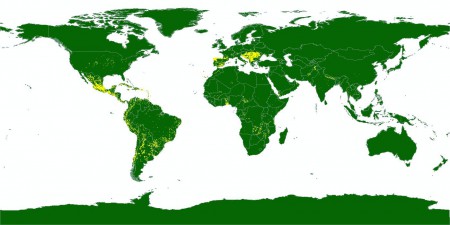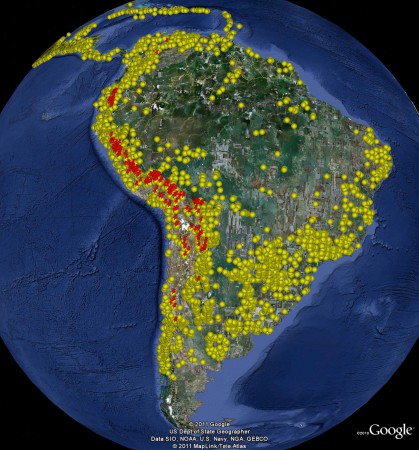- Genetic diversity of Brassica oleracea var. capitata gene bank accessions assessed by AFLP. Czech genebank; subgroups reflected place of origin.
- Optimizing the cropping mix in North Darfur State, Sudan. A study of Umkdada district. “…the results of the model were different from the real practices of the farmers.” Oh dear. To improve the fit, schoolboys should work in the fields more. And crops should fetch more. The dismal science indeed.
- Climate-driven simulation of global crop sowing dates. Ok, this model works. You can predict sowing dates under rainfed conditions for various annual crops from climatic conditions. Not entirely sure why you would want to, though.
- Exploring some of the myths of land use change: Can rural to urban migration drive declines in biodiversity? Yes, counter-intuitively, at least in the forests of Mexico’s southwestern highlands. More from Conservation Magazine.
- Pollination services in the UK: How important are honeybees? Quite a bit, but maybe not as much as previously thought. It’s the wild bees, stupid!
- Genetic diversity and symbiotic effectiveness of rhizobia isolated from root nodules of Phaseolus vulgaris L. grown in soils of Iran. It is high, and it varies, respectively.
- Interspecific hybridization of fig (Ficus carica L.) and Ficus erecta Thunb., a source of Ceratocystis canker resistance. It’s a breakthrough!
- Exploring the diversity of urban and peri-urban agricultural systems in Sudano-Sahelian West Africa: An attempt towards a regional typology. There are 6 types. Not 5; not 7. On this one, the journey is more interesting than the destination.
- Variability of wild olives (Olea europaea subsp. europaea var. sylvestris) analyzed by agro-morphological traits and SSR markers. There’s a lot of variabzzzzzzzzzz…
- Hemp in ancient rope and fabric from the Christmas Cave in Israel: Talmudic background and DNA sequence identification. Mainly flax, but some hemp, from both Roman and Chalcolithic periods. But can you smoke it?
- Modelling the distribution of domestic ducks in Monsoon Asia. Low resolution data, plus fancy modelling, can be used to get pretty good high resolution predictions.
- Gene flow between wheat and wild relatives: empirical evidence from Aegilops geniculata, Ae. neglecta and Ae. triuncialis. It happens, a lot.
- Toward food system sustainability through school food system change: Think&EatGreen@School and the making of a community-university research alliance. Food citizenship?
- Simulation of winter wheat yield and its variability in different climates of Europe: A comparison of eight crop growth models. Big differences among models, so best thing to do is to use the mean of all of them.
- The potential of plant viruses to promote genotypic diversity via genotype × environment interactions. The negative effect of White Clover Mosaic Virus (WCMV) infection on performance differs from white clover genotype to genotypes, which means differential selection, which means negative frequency-dependent selection in host populations, which means diversity. Via.
- Amplifying the benefits of agroecology by using the right cultivars. Why should we summarize, when an author has already done so?
Nibbles: Kew, Chickens, Sorghum, Romanian agriculture, Conferences, Tree conservation
- Kew video asks: Why does plant diversity matter? Not to feed people, obviously.
- An entire blog dedicated to the Origin of the Domestic Fowl! Wonder where he stands on the chickens of Chile?
- Benefits of beer sorghum in eastern Kenya.
- Traditional agriculture protects amphibians in Romania shock.
- Seeds for a sustainable future. Conference organized by European Greens for 31 May. Not much notice, I know.
- And another one, on geographical indications, in June.
- How to develop a genetic conservation strategy to safeguard an endangered tree species. Learning module from Bioversity International.
Snow White and the Four Coconut Types
Over at the Coconut Google Group, Hugh Harris has had enough.
Snow White had no problem – not only was the name of each Disney dwarf carved on the end of the bed, they were identified by easily distinguished features: Happy, Sleepy, Bashful, Sneezy, Dopey, Grumpy and Doc.
Dwarf coconut names are not so simple.
- Dr Nair is looking for a source of green Malayan Dwarf
- Roland thinks there may be half a dozen green dwarf populations in Malaysia, not just one, pure green dwarf
- Dr Srinivasan calls for more insights on the distribution pattern of Malayan Green Dwarf, Brazil Green Dwarf etc.
- Elan Star wants to know about the Samoan or Tongan dwarf in Hawaii.
So perhaps this is a good time to suggest that what is needed now is a Global Coconut Genome Consortium.
For a fee, anyone should be able to send a coconut tissue sample (dwarf, tall, hybrid or unknown) to a collaborating laboratory for a DNA analysis that would identify that sample in terms of its similarity to, or difference from, all previously analysed samples.
The technology is available in many countries on all continents (except Africa?); there are already laboratories able to handle coconut samples in Australia, China, Europe, the USA and Brazil, and probably elsewhere (and the cost is coming down).
There is an International Botanical Congress in Melbourne, Australia, this July. If anyone reading this email is going to that meeting, or knows someone who will be there, please make an opportunity to talk about starting a Global Coconut Genome Consortium (GCGC or GC^2).
In the meantime, returning to the subject of dwarf coconuts, there can never be a 100% “pure” green dwarf or any other coconut (until in vitro propagation methods are a practical possibility).
Indeed, all coconut “varieties” are no more or less than local populations that look phenotypically similar to other populations that share a recent common ancestor.
At the risk of causing more, not less, confusion, I would like to suggest that the commonplace distinction of “tall or dwarf” should be forgotten and replaced. Instead we should recognise four “basic” plant habit phenotypes:
- the tall wild type (with large and small fruited sub-types)
- the tall domestic type (with different fruit-colour sub-types)
- the dwarf domestic type (with different fruit-size and -colour sub-types)
- the compact-habit dwarf (which has all the tall features except internode length)
But each of these basic phenotypes, and particularly the first two, are locally introgressed, so that there appears to be a fifth, intermediate, phenotype. For want of any accepted term, this can be thought of as the common cultivated coconut.
And, Elan, your dwarf is number 4 but if you look around you will certainly see number 3 as well.
So, a Global Coconut Genome Consortium. Any takers?
Maize hits the heights
The llama dung story got me thinking about high-altitude maize. Maize is a tropical plant and it would have taken quite a bit of effort to get it adapted to high elevations. This is what Genesys knows about maize around the world:
And this is (in red) where maize collected above 3,500 masl has been collected:
Those Andean agriculturalists obviously did a pretty good job of breeding maize to fit the new environment, and in fact still are.
LATER: As Jacob helpfully points out in a comment on this post, a 2002 paper confirmed, using microsatellites, that Andean maize is genetically quite distinct.
Brainfood: Introgression, Sorghum and drought, Rice and drought, Carrot evaluation, Wheat breeding, Legume conservation, Wild Tibet soybean, Gezira, Biochar, CA, Grass ecotypes and climate, Organic ag and nutrients
- Alien introgressions represent a rich source of genes for crop improvement. Polyploids such as wheat do it best.
- Characterization of sorghum genotypes for traits related to drought tolerance. There is diversity within the “association panel” of diverse germplasm used. What I want to know is how that is different from a core or mini-core collection.
- Rice near-isogenic-lines (NILs) contrasting for grain yield under lowland drought stress. Small genetic differences can lead to big differences in yield under drought stress. What I want to know is whether doing this on NILs is better value for money than doing it on association panels of germplasm (see above), whatever they may be.
- Towards better tasting and more nutritious carrots: Carotenoid and sugar content variation in carrot genetic resources. European accessions sweeter and more orange than Asian.
- Changes in duration of developmental phases of durum wheat caused by breeding in Spain and Italy during the 20th century and its impact on yield. Fascinating unpicking of just where the genetic changes have their impact.
- Legume genetic resources: management, diversity assessment, and utilization in crop improvement. A lot of characterization, not enough evaluation. Core collections useful, but not useful enough. Crop wild relatives being used, but not enough. Good plug for the importance of geo-referencing.
- Genetic diversity and geographical peculiarity of Tibetan wild soybean (Glycine soja). Low and high, respectively.
- Analysis of agricultural production instability in the Gezira Scheme. Went up for wheat, cotton and sorghum, down for groundnuts, on liberalization.
- Biochar effects on soil biota – A review. It’s complicated but, on the whole, not unpositive.
- A research agenda to explore the role of conservation agriculture in African smallholder farming systems. Basically, it is likely to work least well in marginal conditions. Which is kinda surprising, and not, at the same time.
- Ecotypes of European grass species respond differently to warming and extreme drought. Yeah, but, alas, not in the way one might have wished.
- Comparison of nutritional quality of the crops grown in an organic and conventional fertilized soil. Maybe lower nitrate and N, higher P in organic crops. But really too much variation to be sure.


